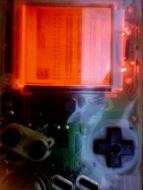Initial Nexus One Impressions
After playing with the phone for about 30 minutes so far:
Hardware
The form factor is very nice. It is indeed thinner than the iPhone, but only by a millimeter or two. It feels thinner, though. The battery cover has soft rubber on it which makes it feel grippable, although it’s probably only a matter of time until that cover gets loose.
The screen is gorgeous. Bright, much denser (ppi-speaking) than the iPhone. Very lovely.
There’s no slient/loud ringer switch. What year is this? You have to go through menus to silence the phone. Silly. (Update: You can hold down the sleep/wake switch to get a shortcut to the software-based silence functionality. While this is better than digging through the menus, I would still prefer a hardware switch because it’s easier to toggle quickly and also to see if a phone is already silenced.)
The sleep/wake button is on the upper left, not the right. This is the opposite of the iPhone but the same as the iPod Touch. I’m already pissed that Apple has their two products using different sides, and I wish as a people we’d just decide on one and stick with it.
The scrollball is almost completely pointless. It lights up when a download starts in the Market, and it allows you to select some items on the interface, but so far I have only used it in one case where an app I downloaded wouldn’t let me hide the keyboard even though it had UI elements below it. The ball allowed me to scroll to those elements. Other than that, it’s useless extra hardware. (Update: Turns out you use the scrollball for text selection. And for good reason: The non-scrollball method is TERRIBLE. It’s inaccurate and a mess. Adding to that, the scrollball moves too slowly, so even using it for text selection is poor at best. But at least I know what it’s for now.)
OS Features
Android OS allows you to create a custom swipe-to-unlock pattern, which is a very neat idea. There are dots on the screen and you choose a pattern to connect them. The only problem with this, as Brian pointed out to me on his G1 last week, is that if you tilt the phone a bit and catch the light on the screen, you can the pattern in oily smudges. So, most likely, you’ll be able to guess someone’s pattern. That said, the Nexus One’s screen is nearly as easy to clean as the iPhone 3GS (is the NO also oleophobic?) so at least if you wipe it before setting it down you’d minimize the risk of someone unlocking it.
Unfortunately, because of the custom swipe pattern, Andriod OS doesn’t allow you to use a passcode to lock the phone. And, given the security issue mentioned above, this is a bad thing. I keep my iPhone passcoded when I’m out because I don’t want people to get my information in case they steal the phone or I lose it. With this device, it’s much more likely they’d be able to get to my data.
I really like the weather/news widget. It works really well and it’s nice to have it on the home screen rather than having to launch two different apps to get this information.
The “Live” wallpapers (animated wallpapers, some of which respond to touch) are ridiculous and completely useless. Not to mention distracting. However, Andriod does this neat thing with non-live wallpapers where it uses a five-screens-wide wallpaper and when you scroll horizontally from screen to screen, the wallpaper moves a little. Very simple and nice effect.
The status bar is too cluttered. People have been joking about it, and it’s true. They need to hide some of this stuff. A great example: When the phone is sending/receiving data from the internet, it shows a huge satellite icon with flashing green bars next to it. It’s distracting and huge, especially compared to the iPhone’s simple spinner. (Update: This icon is actually indicating the phone trying to find your location, which is still unnecessary but less frequent. That being said, there is no system-wide data spinner icon on the Android.)
The phone doesn’t seem to be able to get your location from wifi only. I haven’t put my SIM card in the phone yet, and am just connected to my home network. I’ve yet to get it to even guess at my general location.
Big Issues
Some animations are very smooth, some are janky as hell. The Nexus One has a faster processor than the iPhone 3GS and has twice the RAM, and yet it still cannot have as fluid a UI as the iPhone OS. This is great proof that your software is key—throwing raw power at things won’t necessarily make them better.
The Android Market is a terrible mess. Nearly every app I looked at had nothing but spam comments. Literally things like, “Follow me on twitter at @blah” and “Ladies, hit me up on AIM at blah” which is embarrassing and sad. Makes the entire thing feel like cheap garbage. When you add the fact that nearly all the apps are free, and most are a UI mess, it doesn’t come off too well.
Sometimes the hardware buttons (Back, Menu, Home, Search) don’t respond right away, for whatever reason (software hang, working, etc) and since there’s no way to know if your touch simply wasn’t registered (which is also an issue I’m having from time to time) you end up pushing the button over and over. Then suddenly it will just work. To combat this, I turned on the vibration feedback option for those buttons, but that only partially helped—the phone still won’t vibrate after you push a button if it’s stuck doing something, so I end up pushing it over and over until I feel the vibration. This isn’t an issue on the iPhone because the only hardware button (the home button) is an actual button that clicks in when you push it. So you always know you’ve done so, and if nothing happens you know it’s a software issue.
No multi-touch. Or I should say, none “yet.” Android OS supports multi-touch and so does the hardware, but it has to be built into each app individually. The most obvious and annoying-that-it’s-not-there case is Maps. Zoom in and out buttons on a modern device like this just seems amateur.
Quelle:
http://log.maniacalr...one-impressionsNaja, soviel zum "Super-Smartphone" ^^
Dieser Beitrag wurde von P. Stylez bearbeitet: 08. Jan. 2010 - 00:20 Uhr



 Anmelden
Anmelden Registrieren
Registrieren



 Nach oben
Nach oben












